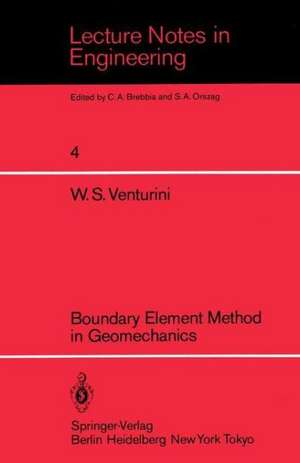Boundary Element Method in Geomechanics: Lecture Notes in Engineering, cartea 4
Autor W. S. Venturinien Limba Engleză Paperback – aug 1983
Din seria Lecture Notes in Engineering
- 15%
 Preț: 640.37 lei
Preț: 640.37 lei - 15%
 Preț: 643.34 lei
Preț: 643.34 lei - 15%
 Preț: 632.70 lei
Preț: 632.70 lei - 18%
 Preț: 1109.16 lei
Preț: 1109.16 lei - 15%
 Preț: 637.59 lei
Preț: 637.59 lei - 15%
 Preț: 638.89 lei
Preț: 638.89 lei - 15%
 Preț: 637.93 lei
Preț: 637.93 lei - 15%
 Preț: 635.96 lei
Preț: 635.96 lei - 15%
 Preț: 637.78 lei
Preț: 637.78 lei - 18%
 Preț: 957.13 lei
Preț: 957.13 lei -
 Preț: 397.01 lei
Preț: 397.01 lei - 15%
 Preț: 653.79 lei
Preț: 653.79 lei - 15%
 Preț: 638.57 lei
Preț: 638.57 lei - 15%
 Preț: 634.82 lei
Preț: 634.82 lei - 15%
 Preț: 644.18 lei
Preț: 644.18 lei - 15%
 Preț: 635.15 lei
Preț: 635.15 lei - 15%
 Preț: 637.93 lei
Preț: 637.93 lei - 15%
 Preț: 633.19 lei
Preț: 633.19 lei - 15%
 Preț: 653.79 lei
Preț: 653.79 lei - 15%
 Preț: 636.45 lei
Preț: 636.45 lei - 15%
 Preț: 651.02 lei
Preț: 651.02 lei - 20%
 Preț: 645.31 lei
Preț: 645.31 lei - 15%
 Preț: 639.08 lei
Preț: 639.08 lei - 15%
 Preț: 633.19 lei
Preț: 633.19 lei - 15%
 Preț: 655.13 lei
Preț: 655.13 lei - 15%
 Preț: 652.49 lei
Preț: 652.49 lei - 15%
 Preț: 652.81 lei
Preț: 652.81 lei - 15%
 Preț: 643.48 lei
Preț: 643.48 lei - 15%
 Preț: 638.24 lei
Preț: 638.24 lei - 20%
 Preț: 640.51 lei
Preț: 640.51 lei - 15%
 Preț: 675.58 lei
Preț: 675.58 lei - 15%
 Preț: 639.59 lei
Preț: 639.59 lei - 15%
 Preț: 642.18 lei
Preț: 642.18 lei -
 Preț: 434.12 lei
Preț: 434.12 lei - 15%
 Preț: 642.68 lei
Preț: 642.68 lei - 15%
 Preț: 647.27 lei
Preț: 647.27 lei - 15%
 Preț: 655.92 lei
Preț: 655.92 lei - 15%
 Preț: 665.73 lei
Preț: 665.73 lei -
 Preț: 411.64 lei
Preț: 411.64 lei -
 Preț: 406.80 lei
Preț: 406.80 lei - 15%
 Preț: 634.68 lei
Preț: 634.68 lei - 15%
 Preț: 650.86 lei
Preț: 650.86 lei - 18%
 Preț: 974.49 lei
Preț: 974.49 lei - 15%
 Preț: 642.68 lei
Preț: 642.68 lei - 15%
 Preț: 635.31 lei
Preț: 635.31 lei - 15%
 Preț: 640.37 lei
Preț: 640.37 lei - 15%
 Preț: 636.45 lei
Preț: 636.45 lei - 20%
 Preț: 659.63 lei
Preț: 659.63 lei - 15%
 Preț: 651.51 lei
Preț: 651.51 lei
Preț: 638.43 lei
Preț vechi: 751.10 lei
-15% Nou
Puncte Express: 958
Preț estimativ în valută:
122.19€ • 127.09$ • 102.40£
122.19€ • 127.09$ • 102.40£
Carte tipărită la comandă
Livrare economică 13-27 martie
Preluare comenzi: 021 569.72.76
Specificații
ISBN-13: 9783540126539
ISBN-10: 3540126538
Pagini: 224
Ilustrații: VIII, 212 p. 4 illus.
Dimensiuni: 170 x 244 x 12 mm
Greutate: 0.36 kg
Ediția:Softcover reprint of the original 1st ed. 1983
Editura: Springer Berlin, Heidelberg
Colecția Springer
Seria Lecture Notes in Engineering
Locul publicării:Berlin, Heidelberg, Germany
ISBN-10: 3540126538
Pagini: 224
Ilustrații: VIII, 212 p. 4 illus.
Dimensiuni: 170 x 244 x 12 mm
Greutate: 0.36 kg
Ediția:Softcover reprint of the original 1st ed. 1983
Editura: Springer Berlin, Heidelberg
Colecția Springer
Seria Lecture Notes in Engineering
Locul publicării:Berlin, Heidelberg, Germany
Public țintă
ResearchCuprins
1 Introduction.- 2 Material Behaviour and Numerical Techniques.- 2.1 Introduction.- 2.2 Linear Elastic Material Problems.- 2.3 Nonlinear Elastic Material Problems.- 2.4 Inelastic Material Problems.- 2.5 Time-Dependent Problems.- 3 Boundary Integral Equations.- 3.1 Introduction.- 3.2 Governing Equations and Fundamental Solutions.- 3.3 Integral Equations.- 3.4 Body Force Problem.- 3.5 Prestress Force Problem.- 3.6 Temperature Shrinkage and Swelling.- 4 Boundary Integral Equations for Complete Plane Strain Problems.- 4.1 Introduction.- 4.2 Governing Equations and Fundamental Solutions.- 4.3 Integral Equations for Interior Points.- 4.4 Boundary Integral Equation.- 5 Boundary Element Method.- 5.1 Introduction.- 5.2 Discretization of the Integral Equations.- 5.3 Subregions.- 5.4 Traction Discontinuities.- 5.5 Thin Subregions.- 5.6 Solution Technique.- 5.7 Practical Application of Boundary Element on Linear Problems.- 6 Notension Boundary Elements.- 6.1 Introduction.- 6.2 Rock Material Behaviour.- 6.3 Method of Solution.- 6.4 Application of No-Tension in Rock Mechanics.- 7 Discontinuity Problems.- 7.1 Introduction.- 7.2 Plane of Weakness.- 7.3 Analysis of Discontinuity Problems.- 7.4 Numerical Applications.- 8 Boundary Element Technique for Plasticity Problems.- 8.1 Introduction.- 8.2 Elastoplastic Problems in One Dimension.- 8.3 Theory of Plasticity for Continuum Problems.- 8.4 Numerical Approach for the Plastic Solution.- 8.5 Practical Applications in Geomechanics.- 9 Elasto/Viscoplastic Boundary Element Approach.- 9.1 Introduction.- 9.2 Time-Dependent Behaviour in One Dimension.- 9.3 Elasto/Viscoplastic Constitutive Relations for Continuum Problems.- 9.4 Outline of the Solution Technique.- 9.5 Time Interval Selection and Convergence.- 9.6 Elasto/Viscoplastic Applications.-10 Applications of the Nonlinear Boundary Element Formulation.- 10.1 Introduction.- 10.2 Strip Footing Problem.- 10.3 Slope Stability Analysis.- 10.4 Tunnelling Stress Analysis.- 11 Conclusions.- References.- Appendices.












